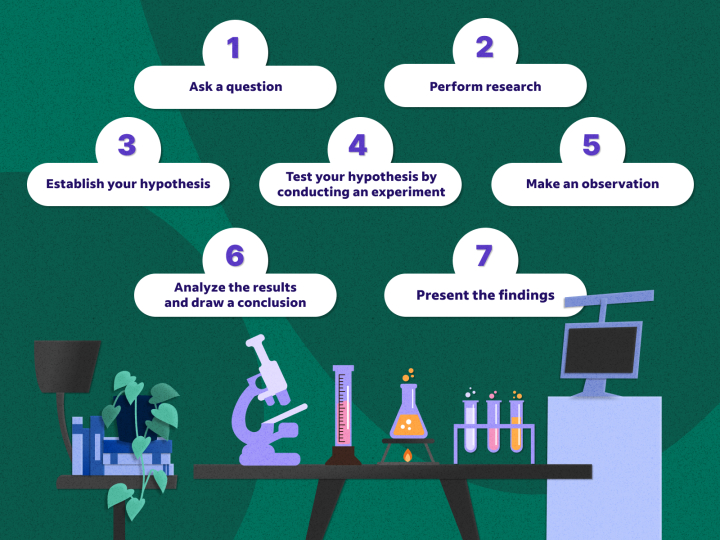Study like a Scientist: Using the Scientific Method in Your Learning Process
Academic achievement is not simply about talent or the amount of time you spend studying; it is about how you do it. What if students approached learning in the same way that scientists approach experiments? By using the scientific method in your study practices, you can increase the efficiency, organization, and results orientation of your learning.
We will discuss in this article how to approach learning like a scientist, transforming speculation into strategy and uncertainty into certainty.
What Is the Scientific Process?
The scientific approach is a systematic method of problem solving and solution discovery. It consists of the following steps:
Noticing
The question is whether or not
Hypothesis
Test
Examining
In conclusion
For centuries, this approach has fueled advances in science, and it may also transform your academic achievements.
Step 1: Observation - Evaluate Your Existing Study Practices
Students must begin by identifying patterns in their learning habits, much like scientists who examine the environment.
Ask yourself:
What are the times when I am most focused?
Which topics are the most challenging to remember?
What interruptions throw my sessions off track?
Record these observations without making any judgments. This may be considered your baseline information.
Step 2: Ask – Identify a Particular Learning Challenge
Based on your observation, ask a precise and practical question.
Some instances are:
Why do I forget the subject I'm studying the night before the test?
How can I maintain my attention for longer than thirty minutes?
How do I learn complicated ideas more effectively?
You can focus your learning problem as if it were a genuine scientific inquiry because of this clarity.
Step 3: Hypothesis – Make an Informed Prediction
A hypothesis is an hypothesis that can be tested.
Examples of hypotheses:
"I will remember more a week later if I use active recall rather than reading. "
"My concentration will improve if I take little breaks every 30 minutes. "
Make a note of what you expect to happen. At this point, you're conducting a learning experiment.
Step 4: Try a New Learning Strategy:
It's time to take action. Use your new approach for a predetermined amount of time (e. g. , a week). Among other things, this could involve:
Using the Pomodoro method, which consists of 25 minutes of studying followed by a 5-minute break.
Switching from flashcards to passive reading
Learning in a setting with few distractions
The subject should be taught to others.
Note any changes in performance or feeling while maintaining consistency.
Step 5: Examine the Results and Reflect
Assess the conclusion of your learning experiment.
Ask yourself:
Did I recall more during my tests?
Did I maintain my concentration while studying for a longer period of time?
Was I more self-assured following study sessions?
To keep track of things like energy levels, retention, and grades, use monitoring applications or keep a study journal.
Step 6: Conclusion – Determine What Works
Just like in science, not all ideas are supported by evidence, and that's alright. The goal is to figure out what works for you. Keep the new strategy if it was successful. If not, modify and experiment with other approaches.
For example, "Active recall increased my retention by 30%, thus I'll utilize it for every topic. "
Supported by logic and testing, this is individualized learning at its finest.
The Advantages of Studying Like a Scientist
Better Memory – You use strategies that have been shown to be effective for your mind
Progress Based on Data – You measure what works, not what feels familiar.
Utilize your time more wisely by focusing on productive learning and avoiding unproductive hours.
A Growth Mindset means that errors become feedback, not failures.
Pro Tip: Use Study Tools in conjunction with it
Tools like the following can help you get even more out of this strategy:
Evernote or Notion: For organizing and journaling
Quizlet or Anki: For experiments based on flash cards
Pomofocus vs. Forest: Evaluating Attention Strategies
Google Sheets or Excel: To monitor research results
Make your mind a lab, in summary.
There is no one way to learn. By using the scientific method, you give yourself the power to learn more effectively rather than just harder. With this attitude, studying becomes more interesting, individualized, and rewarding.
Therefore, the next time you find yourself at a loss with a topic or at a loss with a routine, use your scientific mind. Develop a theory, experiment with a plan, evaluate your findings, and then grow.
Trial, measurement, and mastery are what learning is all about, not trial and error. Begin your experiment right now!


Post a Comment
0Comments